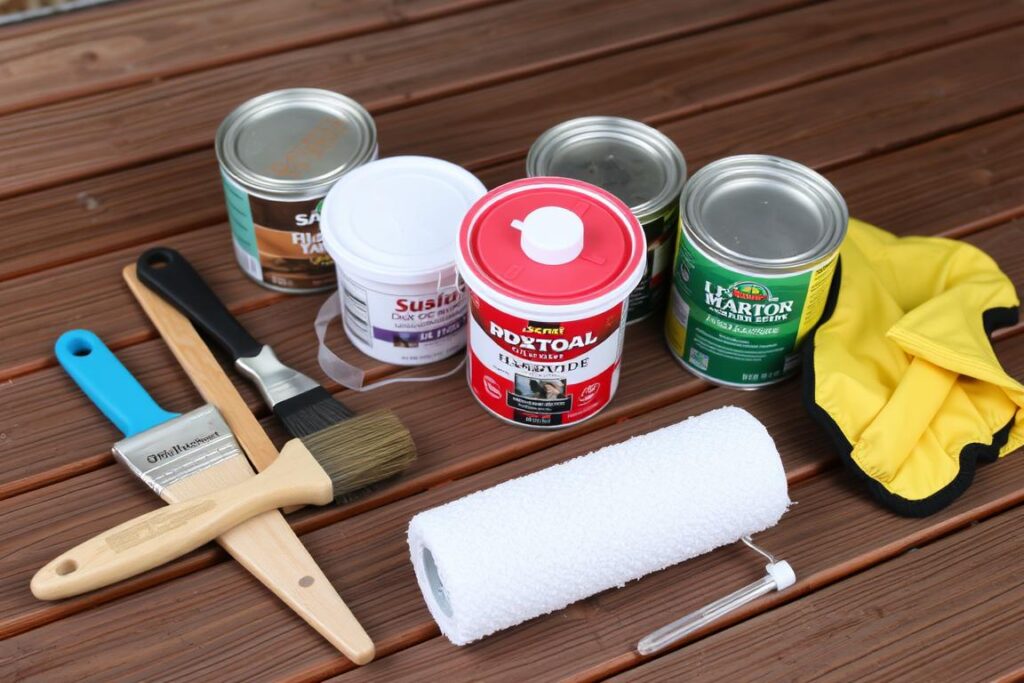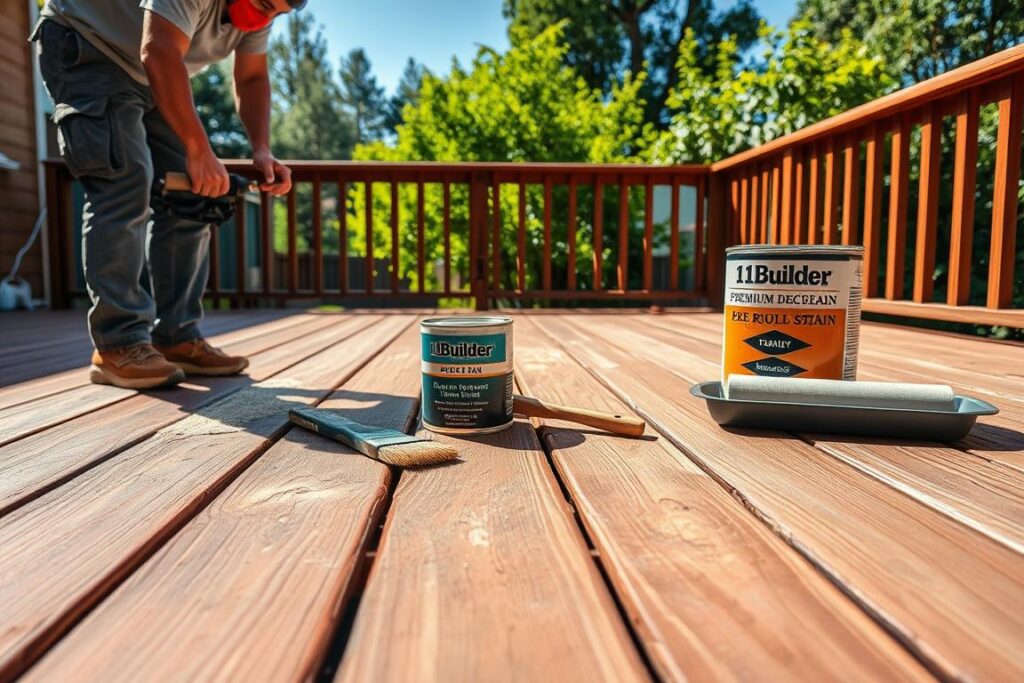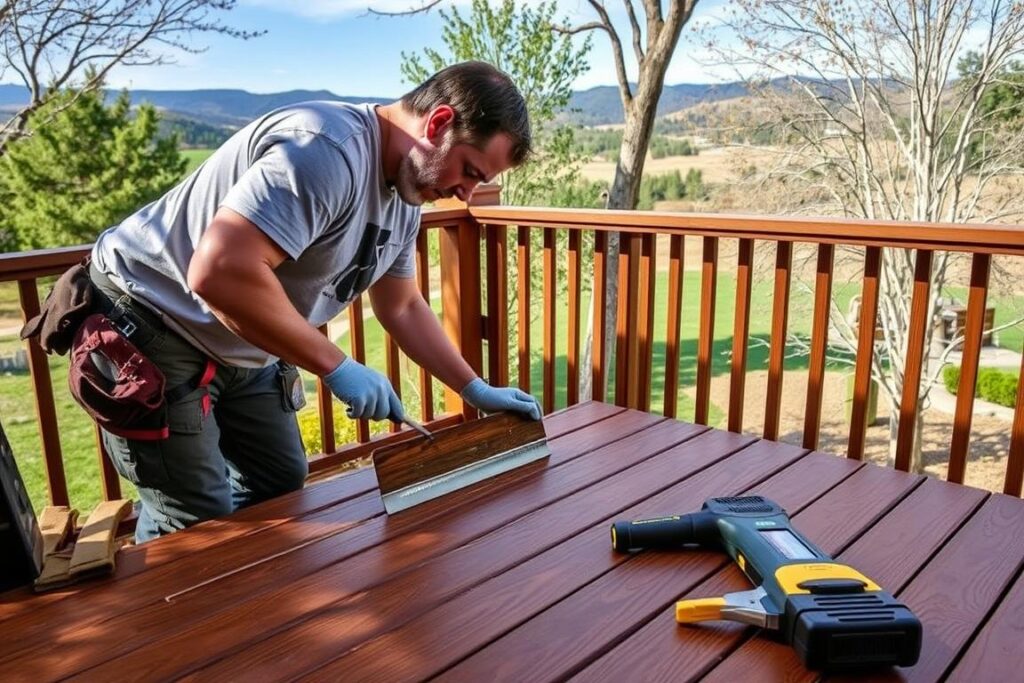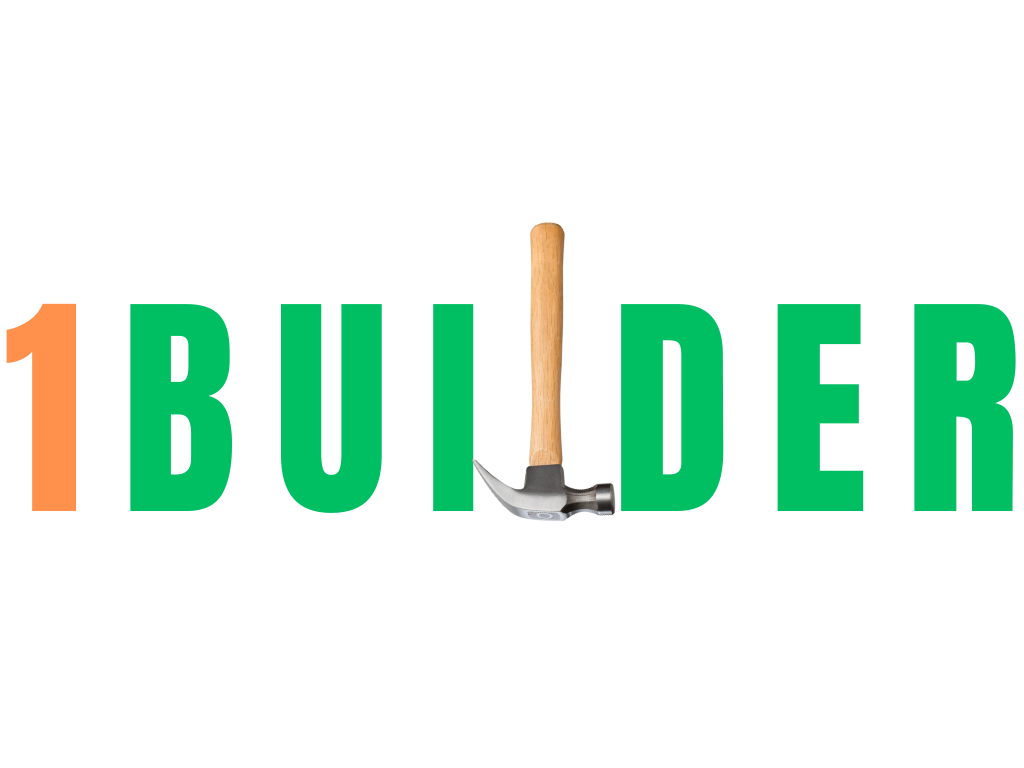As homeowners in Placerville, CA, we understand the importance of maintaining our outdoor living spaces. A well-maintained deck not only enhances the aesthetic appeal of your home but also provides a functional area for relaxation and entertainment. However, the local climate, with its hot, dry summers and wet winters, can take a toll on your wood deck’s integrity.
At 1Builder Handyman Services, we have over 16 years of experience in transforming homes through quality craftsmanship and exceptional customer service. Our team specializes in deck repairs, maintenance, and installation services. We will explore the essential stain and finish techniques to protect your deck from damage and extend its lifespan.
Key Takeaways
- Understand the importance of regular deck maintenance for longevity.
- Learn the best practices for stain and finish application.
- Discover how to protect your deck from Placerville’s seasonal weather conditions.
- Find out when to consult professional deck maintenance services.
- Enhance your deck’s natural beauty and your home’s overall value.
Understanding Deck Maintenance in Placerville’s Climate
Maintaining a deck in Placerville, CA, requires a deep understanding of the local climate’s impact on wood. The region’s weather patterns are characterized by hot, dry summers and wet winters, which can cause significant stress to deck materials.
Weather Challenges for Deck Owners
Placerville’s climate presents unique challenges for deck owners. The intense sun exposure during the summer months can cause wood to dry out and crack, while the wet winters introduce moisture that can lead to mold and rot. The significant temperature fluctuations in the region also cause wood to expand and contract, creating stress on deck boards and fasteners.
Why Regular Staining and Sealing is Essential
Regular staining and sealing are crucial for protecting decks from the elements. Staining provides a barrier against UV rays, which can cause wood to gray and deteriorate, while sealing helps to prevent moisture absorption. The type of stain used can also impact the frequency of reapplication; for instance, solid stains may need to be reapplied more frequently than clear or wood-toned treatments.
| Maintenance Task | Frequency | Benefits |
|---|---|---|
| Staining | Every 1-3 years | UV protection, color retention |
| Sealing | Every 2-5 years | Moisture protection, reduced warping |
By understanding the challenges posed by Placerville’s climate and taking proactive steps to maintain their decks, homeowners can extend the life of their outdoor structures and keep them looking their best.
Essential Tools and Materials for Deck Staining and Sealing
The key to a beautifully stained and sealed deck lies in using the right equipment and products.

Required Tools for a Professional Finish
Safety Equipment
To protect yourself during the deck staining process, you’ll need safety goggles, a respirator mask, and chemical-resistant gloves. These will shield you from potential splashes, harmful fumes, and skin irritation.
Application Tools
For a smooth and even application, use a high-quality paint roller with the appropriate nap length (1/4″ for smooth surfaces, 3/8-1/2″ for rough surfaces). Natural-bristle brushes are ideal for oil-based stains, while synthetic brushes work well with water-based stain.
Choosing the Right Stains and Sealers
Oil-Based vs. Water-Based Products
When selecting a stain for your deck, consider the benefits of oil-based versus water-based products. Oil-based stains offer durability and deeper penetration, while water-based stains provide easier cleanup and faster drying times.
Recommended Brands for Placerville’s Climate
For Placerville’s variable climate, we recommend using wood stain products with added mildewcides to combat seasonal moisture challenges. Some effective brands include those that offer semi-transparent options for UV protection and solid stains for older decks.
Preparing Your Deck for Staining and Sealing
Proper deck preparation is the foundation of a successful staining and sealing project in Placerville, CA. Ensuring your deck is ready for the staining process not only enhances the appearance but also extends the lifespan of your deck.
Conducting a Thorough Deck Inspection
Before applying any stain or sealer, we conduct a comprehensive inspection of the deck to identify any safety hazards or areas that need repair. This includes checking for loose boards, protruding nails or screws, splintered wood, and signs of rot or structural damage.
Cleaning Techniques for Optimal Results
Effective cleaning is crucial for removing dirt, mildew, and algae that can prevent the new stain from adhering properly to the wood surface. We use a deck cleaner applied with a paint roller or a stiff-bristled push broom, ensuring not to allow the cleaner to puddle.
Using Deck Cleaners Effectively
When using chemical deck cleaners, it’s essential to protect surrounding plants by wetting them first and covering them with plastic sheeting. The cleaner should be allowed to soak into the wood for the recommended time, usually no more than 10 minutes, before rinsing thoroughly with a garden hose or pressure washer.
Pressure Washing Best Practices
Pressure washing can be effective but requires careful technique. We maintain a consistent distance of 6-8 inches from the wood surface and use medium pressure (1200-1400 PSI) to avoid damaging the wood.
Sanding and Repairs Before Staining
After cleaning, we sand splintered areas with 80-grit paper and repair or replace damaged boards. It’s also crucial to drive in any popped nails or replace them with deck screws. Allowing the deck to dry completely for at least two days before applying stain ensures proper absorption and adhesion.

As emphasized by professionals, “80% of staining success comes from thorough preparation work.” By following these steps, we ensure a beautifully stained and sealed deck that will last for years to come.
Deck Staining and Sealing Placerville CA Best Practices
The key to a successful deck staining project in Placerville, CA lies in understanding and implementing industry-recognized best practices. We will guide you through the essential steps to ensure a long-lasting and beautiful finish for your deck.
Timing Your Project for Placerville’s Weather
Timing is crucial when it comes to deck staining in Placerville, CA. Ideal conditions include temperatures between 50-90°F, moderate humidity (40-70%), and no rain forecast for at least 48 hours after application. The best seasons for this project are typically late spring (May-June) and early fall (September-October).
Testing Wood Readiness with the Water Test
Before applying any stain or sealer, it’s essential to test your deck’s wood readiness using the simple water test. Sprinkle water on the deck surface; if it absorbs quickly, the wood is ready for staining. If the water beads up, the surface may still have residual sealers or require additional preparation.
Application Techniques for Even Coverage
To achieve an even coat, apply stain or sealer in thin layers, working in sections of 2-3 boards at a time. This technique ensures that the product is evenly distributed and absorbed properly into the wood.
Working with the Wood Grain
Always apply stain in the direction of the wood grain to maintain a uniform appearance and prevent damage to the wood. This technique is crucial for achieving a professional-looking finish.
Preventing Lap Marks and Puddles
To avoid lap marks and puddles, maintain a wet edge by working quickly and continuously in one direction. It’s also important to avoid over-application, as excessive product can create a tacky surface that will peel and flake prematurely.
| Best Practice | Description | Benefit |
|---|---|---|
| Timing | Apply stain in temperatures between 50-90°F with moderate humidity. | Ensures proper stain absorption and drying. |
| Water Test | Sprinkle water on the deck to check readiness. | Determines if the wood is ready for staining. |
| Application Technique | Apply thin coats, working with the wood grain. | Provides even coverage and prevents damage. |
Step-by-Step Guide to Staining Your Deck
A well-stained deck not only enhances your outdoor living space but also protects it from the elements. To achieve a professional finish, follow our step-by-step guide on staining your deck.
Staining Railings and Vertical Surfaces First
Begin by staining the railings, posts, and balusters with a paint brush or hand-held paint pad. Use long, even strokes to ensure a uniform coat. It’s essential to stain the inner and outer sides of the deck stair handrails. Always start with vertical surfaces to prevent drips and splatter from falling onto already-stained horizontal surfaces.
Applying Stain to Deck Boards
When moving to the deck boards, work in small sections of 2-3 boards at a time. Apply stain using a roller or pad applicator attached to an extension pole, working with the grain in long, even strokes. Pay special attention to board ends, as they absorb more stain and are vulnerable to moisture damage.
Finishing Touches for Stairs and Details
For stairs and detailed areas, use a combination of brushes and small pads to ensure complete coverage. This includes risers, treads, and the spaces between boards. Take your time to ensure all surfaces are evenly coated. By following these steps, you’ll achieve a beautifully stained deck that will last for years to come.
Sealing Your Deck for Maximum Protection
After staining your deck, the next vital step is applying a sealer for maximum protection. Sealing your deck enhances its durability and maintains its appearance over time.
When to Apply Sealer After Staining
It’s crucial to allow the stain to dry completely according to the manufacturer’s recommendations, typically between 24 to 48 hours, before applying sealer. This ensures maximum adhesion and effectiveness of the sealer.
Application Methods for Different Deck Types
Different deck materials require specific sealing approaches. For instance, cedar and redwood decks benefit from penetrating sealers that enhance their natural oils, while pressure-treated pine decks often perform better with film-forming sealers. When applying sealer, start with vertical surfaces, then move to horizontal boards, working in manageable sections with the grain.
How Many Coats of Sealer to Apply
For most residential decks, two thin coats of sealer provide optimal protection. The first coat penetrates deeply, while the second creates a more substantial moisture barrier. Ensure the first coat is completely dry before applying the second coat.
Maintenance Tips for Long-Lasting Results
In Placerville’s climate, deck maintenance is not just about aesthetics; it’s also about durability. To keep your deck in top condition, we recommend a regular maintenance schedule tailored to the local seasonal changes.
Seasonal Maintenance Schedule for Placerville Decks
Establishing a routine based on Placerville’s seasonal climate will significantly extend the life of your deck’s finish and the structural integrity of the wood. Here’s a breakdown:
- In spring (March-April), conduct a thorough cleaning to remove winter debris, check for water damage, and repair any warped or cracked boards.
- During summer (June-August), perform the water test monthly to ensure the sealer is still effective.
- In fall (September-October), remove fallen leaves promptly and prepare the deck for winter by ensuring the seal is intact.
- Winter care should include removing snow promptly with plastic shovels and avoiding ice-melting chemicals.
Signs Your Deck Needs Resealing or Restaining
Watch for signs that your deck needs attention, such as water absorption, visible graying or darkening of wood, splintering surfaces, or mold and mildew growth. Most decks in Placerville require resealing every 1-2 years and complete restaining every 2-3 years. For decks with uneven wear patterns, consider spot-treating high-wear areas annually.
Professional Deck Staining and Sealing Services in Placerville

With years of experience, 1Builder Handyman Services provides top-notch deck staining and sealing services in Placerville, CA. Our team specializes in transforming homes through reliable, efficient, and professional services tailored to meet the unique needs of every client.
We offer comprehensive deck maintenance services, including inspection, cleaning, repairs, staining, and sealing. Our expertise ensures even coverage, proper product penetration, and techniques that minimize common issues like lap marks and uneven coloration, protecting your wood deck from damage.
FAQ
How often should I stain my deck in Placerville’s climate?
We recommend staining your deck every 2-3 years, depending on the type of wood and the amount of sun exposure it receives. Regular inspections will help determine the right time for restaining.
What’s the best way to clean my deck before applying stain?
Use a pressure washer with a wide fan tip and low pressure (around 1,000-1,200 PSI) to clean your deck. Apply a deck cleaner, let it sit for a few minutes, and then rinse thoroughly. Allow the deck to dry completely before staining.
Can I stain my deck in the rain or direct sunlight?
No, it’s best to stain your deck in shaded conditions or on a cloudy day. Avoid staining in direct sunlight or when rain is forecasted within 24 hours. This ensures proper stain absorption and drying.
How do I choose the right stain for my deck?
Consider the type of wood, desired color, and level of protection needed. Solid stains provide more protection, while transparent stains showcase the wood grain. We recommend testing samples on a small, inconspicuous area before making a final decision.
What’s the recommended drying time between coats of stain or sealer?
Typically, you should wait at least 24-48 hours between coats, depending on the product and weather conditions. Always follow the manufacturer’s instructions for specific drying times.
How can I ensure even coverage when applying stain or sealer?
Use a high-quality brush or roller specifically designed for exterior use. Work in sections, applying the product in smooth, even strokes. Use a lambswool applicator for railings and vertical surfaces.
What are the signs that my deck needs resealing or restaining?
Look for signs of wear, such as fading, cracking, or peeling of the existing stain or sealer. If you notice water is no longer beading on the surface, it’s likely time to reseal. Regular inspections will help you catch these signs early.



